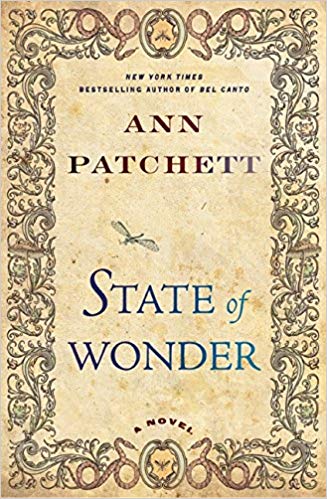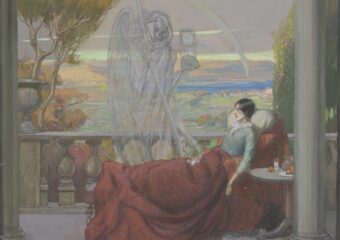Ann Patchett
Harper
New York
2011
353 pages
According to the Art:
In her novel set in the Amazonian jungle, Ann Patchett offers complex questions to contemplate for readers interested in the wisdom of enabling fertility in later life, the ethics of human subjects research involving indigenous populations, and the propriety of certain conduct scientists defend using a form of casuistry.
Synopsis:
Dr. Marina Singh, an obstetrician–cum–pharmacologist, is sent to a research site in the Amazonian jungle somewhere in Brazil that the company she works for, Vogel Pharmaceutical, operates. The company chief executive officer, Mr. Fox, dispatches her there to check on the progress of the research program and to get details on the reported death of her colleague, Dr. Anders Eckman, while he was there on a previous research trip. Eckman’s wife, uncertain that he was dead, asks Marina to find out what had happened to her husband. The plot centers on Marina’s dual missions at the Amazon jungle site.
Marina’s trip reunites her with the legendary and imperious Dr. Annick Swenson, who is an obstetrician and the lead researcher at the site. Thirteen years before, Swenson was Marina’s supervisor during her obstetrics residency. A mistake Marina makes while she’s delivering a baby after disregarding Swenson’s advice drove her out of obstetrics and into pharmacology, and then eventually to Vogel. The company is supporting Swenson’s research hoping it will produce a blockbuster product. Mr. Fox is growing impatient having received only brief and vague communications from Swenson over the past five years.
Decades earlier Swenson had followed her mentor to the jungle location where the Lakashi tribe lived, and after frequent visits over this time, resided there permanently to work on the research Vogel was funding. The research was based on observations Swenson and her mentor made about Lakashi women; they never go through menopause and they are fertile into their old age. Swenson’s project is to find out why, and provide the information to Vogel in order to develop a product that could give women a choice to avoid menopause and a choice to have babies much later in life.
Swenson finds it is the bark of the (fictional) Martin trees when combined with excretions of the (fictional) Purple Martinet moth deposited in the bark Lakashi women ingest that extends their fertility after menopause. Trying it herself, Swenson becomes pregnant at age seventy–three. She also finds that the same bark protects the Lakashi women against malaria. Swenson eventually concludes that her research should not proceed to product development for fertility, but instead for prevention of malaria. Certain that no American pharmaceutical company would “foot the bill for Third World do-gooding,” Swenson decides to reallocate the fertility research funding to her malaria vaccine work without permission from the company. (p. 289) A cat and mouse game ensues around the research funding, Swenson’s pregnancy ends, the mystery of what happened to Anders Eckman is solved, and Marina Singh’s life is probably changed forever.
Analysis:
Patchett offers enough adventure, mystery, and literary flourish in this novel to satisfy readers just interested in a good story. She also offers complex questions to contemplate for readers interested in the advisability of enabling fertility later in life, the ethics of research involving indigenous populations, and the propriety of certain conduct scientists defend using a form of casuistry. Casuistry in this instance refers to methods for resolving practical moral problems that put an emphasis on case specifics or circumstances rather than on strict readings of moral principles or rules, which may or may not exist. This method can lead to relevant and ethically-justifiable actions, but it can also be abused when the arguments are tautological, irrelevant, or used when established moral principles are available, persuasive, and instructive.
The question the novel raises of whether ovarian function should be extended beyond its natural age span just because it can is not science fiction. The science of preserving and reactivating ovarian function is available from health care provider organizations offering a range of services approximating what Patchett’s fictional scientists were after. Patchett acknowledges the prima facie appeal of the opportunity through one of Swenson’s assistants who says, “To think of being able to wait and have your children whenever you want them, forty, fifty—sixty even, that would be amazing.” (p. 119)
Patchett, the novelist, is not sold on the idea, at least not without conditions, as she voices through her lead scientist, Annick Swenson.
I am glad to have conducted this piece of research on myself because it makes me realize something I might not have otherwise taken into account: women past a certain age are simply not meant to carry children, and I can only imagine that we are not meant to bear them or to raise them either. The Lakashi are used to it. This is their particular fate. They can hand off their infants to their granddaughters. They don’t have to raise them. That is the only reward for these late–life children: you know they won’t be your responsibility.
pp. 248-249
Here Patchett is using this particular scenario of extending fertility past its natural senescence to urge scientists, particularly those in Biomedicine, to consider the social and cultural implications—nay, obligations—their discoveries impose, and in particular whether they could or should be accommodated. Swenson is shown to have done just that when she made her decision to shift from fertility to malaria research.
I had no desire to synthesize a compound. I’ve never believed the women of the world are entitled to leave every one of their options open for a lifetime. I believe it less now that I am pregnant.
p. 287
I’ve seen my own menstruation return at sixty. I’ve lived through the pimples and the cramps and I will tell you there was nothing there to enjoy. I did not need to see that aspect of my youth again…This has all been positive. We are very close to securing a vaccine, and in addition to that we know what the body has told us all along, postmenopausal women aren’t meant to be pregnant. That is what we had to learn.
p. 311
Swenson’s logic to spend the money intended for fertility research on malaria research instead is understandable on the face of it. She justifies this action on her scientific knowledge, clinical judgment, and global health objectives, and asks Marina to help her keep Vogel in the dark. Left unchallenged, Patchett could be seen as defending this action and encouraging researchers to reallocate research funding as they see fit. But, she has Marina resist Swenson’s entreaties for her help saying, “But why would I do that? They’re paying out enormous sums to develop the drug that you brought to them, that you proposed.” (p. 288) In Swenson’s counter, Patchett frames a form of casuistry that has plagued and compromised biomedical research from early on to this day.
The drugs are intertwined…When we get one drug we’ll have the other, and I don’t see the harm in making an American pharmaceutical company pay for a vaccination that will have enormous benefits to world health and no financial benefits for company shareholders. The people who need a malarial vaccine will never have the means to pay for it. At the same time I will give them a drug that will, if anything, undermine the health of women and make them a truly obscene fortune. Isn’t that a reasonable exchange?
p. 288
Patchett leaves us with the warning about abusing casuistry but not the consequences of it. The book ends before Swenson’s actions are addressed, for example whether she would be required to return money or would lose her credentials and eligibility for future funding.
The malaria research adds to the many fictional and nonfiction accounts of indigenous populations being exploited for personal and commercial gains. Consuming the bark of the Martin tree protected Lakashi women from malaria (and there may have been an addictive component of the bark that made them always come back for more). The Lakashi men did not eat the bark and so they were vulnerable. Swenson’s researchers infected various Lakashi men without their explicit consent, and when Marina asks how, she’s told by one of the researchers, “I’ve got some Cokes in here…They love them” (p. 294). In response to Marina’s revulsion, the researcher continues, “Don’t make this out to be the Tuskegee Institute. Chances are excellent that these men have had malaria before, or that they would have had malaria eventually. The difference is that when they get it in this room we’re also going to cure it.” (p. 294) More abuse of casuistry.
The link between the book and its title is not explicit or obvious. It could derive from how the jungle overwhelms each of the senses, wondrous as the characters’ descriptions are of the sights, smells, sounds, tastes, and touches they encounter. It could derive from the Swenson’s and her mentor’s unexpected realization about the Lakashi exended fertility and malarial resistance that drove them to understand their biology and replicate it for the good of humankind. Or, the title could refer to a state of wonder, as the indecisiveness about whether enabling pregnancy late in life is a good idea. Reader’s choice.
A broader perspective of this book shows how a novelist can probe science and generate questions about it, warn of possible negative implications, and generate reasonable doubt and skepticism. In this way, novelists serve to shake the scales from our eyes and put us in a state of wonder over whether any particular scientific program is on the right path.
Also:
Hanya Yanagihara’s novel, People in the Trees explores the related topic concerning the wisdom of extending age well beyond current limits, and is reviewed here.
Background on casuistry is from: Jonsen AR, Toulmin S. The Abuse of Casuistry: A History of Moral Reasoning. Berkely; University of California Press, 1988.
A version of this post is at the NYU Literature, Arts and Medicine Database



